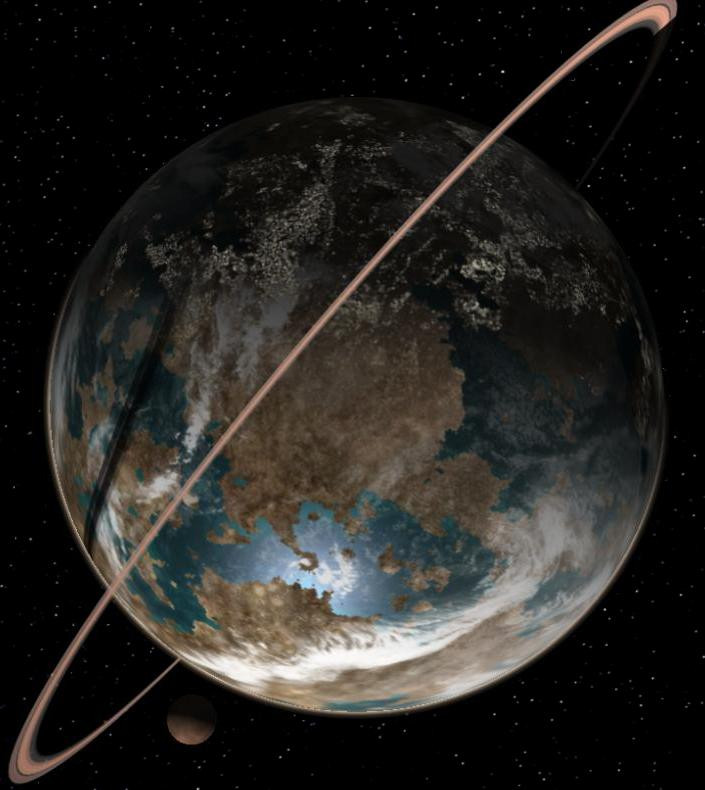HOME | DD
 Killgareth — Ca'Raak
Killgareth — Ca'Raak

#alien #celestia #planet #sciencefiction
Published: 2017-05-07 10:56:11 +0000 UTC; Views: 2129; Favourites: 16; Downloads: 13
Redirect to original
Description
Star
Name: Nedika
Type: G9V
Mass: 0.84 sol
Luminosity: 0.55 sol
Age: 4.5 billion years
Planets: Domra'jesh, Ca'Raak, Trisi'ra, Na'trulanoj (Gas giant), Ive'firsae, Urraku, Aror'Mful (Gas giant)
Ca'Raak:
Semi-Major Axis: 0.52 AU
Period: 151 days
Radius: 6214 km
Mass: 1.017 earth mass
Gravity: 1.07 g
Rotation: 61 hours
Mean Temperature: 40C
Atmosphere: 1.3 atm (N2 43%,O2 30%,O3 16%,SO2 4%, H2S 1%)
Water Coverage: 45%
Moons: Rings (Distance: 9315 km, Width: 750 km), Ros'on (Distance: 27,627 km, Period: 12.5 hours, Radius: 926 km) Kahantau (Distance 89,000 km, Radius: 1290 km)
Continents: Forrarun, Navano
Major Cities: Hetedeal, Duraki, Makshi, Zarazite, Heledium, Tarase, Nerina, Sattam, Nitri, Vij'da, Yadilia, Mila'kar
Population: 20 billion
Affiliation: Crakosian Interplanetary Confederacy
Ca'Raak, better known as Crakosia, is a world very similar in size, mass and age to Earth, but with significant differences. Orbiting a G type star half as bright as Sol at a distance of 0.52 Au, with a period of 151 days and a 61 hour rotation, Ca'Raak is the second planet of Nedika. While it sits comfortably in the habitable zone, it is far from a temperate garden world; while until the recent past it had a trhiving ecosystem, some ten to fifteen million years ago the planet suffered a global cataclysm when a relatively large and metal rich asteroid, estimated several times larger than the one which caused the Cretaceous extinction, was caught in the gravity of the planet. Instead of hitting the planet directly, which would have most likely ended all life on Ca'Raak, the asteroid disintegrated as it passed to close to the superterrestrial Trisi'ra and its remains hurled at Ca'Raak.
While much of the debris was caught in a semi stable orbit around the planet as eventually accreted into a small moon, the rest impacted the planet in a deadly meteor rain. Much of the planet's ecosystem was devastated, but the worse was yet to follow. While the new moon started to come together, the heavy metals that formed the asteroid, among which were selenium, lead and even arsenic, all of which are toxic to carbon based life, contaminated the environment. Around 40% of all life died off due to the initial impact, and another 40% due to the heavy metal pollution. Only the species capable of living with the high concentrations or were lucky managed to survive, and even after several million years the planet's crust and water supply still has a dangerous level of toxicity to non crakosian carbon life, and the environment itself has yet to fully recover, although evolution has lead to the emergence of some very hardy life forms, such as the crakosian themselves, who besides being robust and intelligent are also highly resilient to high levels of toxins.
Its surface still shows numerous impact craters, although most are heavily eroded. Its landmasses are divided into two supercontinents, Forrarun and Navano, which are divided by the Rissa ocean and numerous smaller seas. Both Forrarun and Navano are subjected to high temperatures averaging 40 degrees C, thanks to a very low axial tilt, and are covered by prairies and savannas, pocketed by small outgrown of forests and, of course, dotted by impact craters.The crakosians are divided into 26 nations, all of which are heavily industrialized as the Crakosians have been spacefaring for almost a thousand years. These 26 nations, along with fourteen colonies, form the Crakosian Interplanetary Confederacy, a lose military and economic alliance with the capital in the Ca'Raak city of Hetedeal.

























